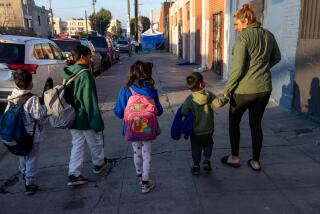L.A., Firms on Skid Row OK 1-Year Plan on Shelter for the Homeless
The Los Angeles City Council on Friday approved a compromise between the city and Skid Row area business owners that will permit an idled, 138-bed emergency shelter for the homeless to relocate and reopen for one year.
But the settlement and a months-long standoff that preceded it show that the city’s long-range strategy of pushing Skid Row eastward, away from downtown, will face new challenges from the growing fish processing and wholesale toy businesses in the area.
The city has already yielded to the business interests and revised one central element of its strategy. It has abandoned a plan to move and expand the Union Rescue Mission eastward from Main Street to 6th and San Pedro streets, the site of the new temporary shelter. The city still wants to relocate the mission, one of the area’s largest, but has agreed in the compromise not to use the 6th and San Pedro site.
“There’s another player . . . at the table,” Murray Kane, the city Community Redevelopment Agency’s attorney, said in referring to the business group.
Friday’s action, if approved as expected by Mayor Tom Bradley, will permit a plywood dormitory--sometimes called the San Julian Shelter--to open before Thanksgiving.
Built hastily last winter with donated materials and union labor, the shelter replaced beds lost when a heavily publicized tent city, erected by activists for the homeless in the heart of the Civic Center, was closed shortly after last Christmas.
With agency funds, the shelter, cited as an example of the Bradley Administration’s concern for the homeless, operated on a vacant city lot at 5th and San Julian streets for six months before being closed last June to make way for a new park. The 138 beds in the temporary shelter were moved to the Weingart Center, a large Skid Row service agency near 6th and San Pedro.
But when the agency tried to re-establish the plywood shelter on San Pedro, leaders of that area’s growing fish processing and wholesale toy industries protested, claiming the shelter would violate zoning laws, create security problems and undermine their efforts to revitalize the area. The businesses won a ruling against the city from a city zoning administrator that was overturned by the Bradley-appointed Board of Zoning Appeals.
Appealed to Council
The businesses, which have recently organized as the Central City East Assn., then appealed that decision to the City Council.
The compromise was reached earlier this week, averting a potentially embarrassing fight between Administration officials and the business owners on the council floor.
Donald Steier, general counsel for the business group, characterized the fight over the shelter as “a start” of a re-examination of policies, adopted several years ago by the council and the mayor, to expand and shift services for indigents eastward to reduce the number of wandering street people in the Civic Center and central business districts.
The group has found a sympathetic ear in downtown Councilman Gilbert Lindsay, who told council colleagues Friday that he has no intention of allowing a “total concentration” of homeless shelters in the area. Lindsay, whose office helped work out the compromise, warned that if the shelter is not torn down a year after opening, “in a year and a day I’ll be there taking it down.” He repeated earlier calls for creation of an “outdoor home” for street people in Saugus, on the city property that Bradley offered this week as a state prison site.
More to Read
Sign up for Essential California
The most important California stories and recommendations in your inbox every morning.
You may occasionally receive promotional content from the Los Angeles Times.










